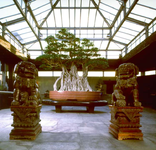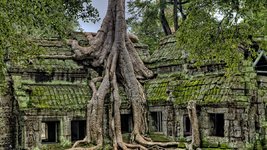I am skeptical of the extreme age, just given the growth rates of ficus and thickening of vascular tissue and roots. It is hard to imagine that it spent any significant amount of time in the ground during its history since it seems like the basal trunks would be more massively fused. So it would have had to spend the majority of that time in a restricted root environment being aggressively pruned essentially has a penzai or some type of garden/temple tree. To survive that length of time, it would seem that it had been in the possession of very wealthy family or families that could trace their roots across several dynasties or it resided in some type of temple or sacred space. Over 1000 yo in 1986 would put it a couple hundred years after the 1st graphical evidence of miniaturized tray landscapes in China (
https://en.wikipedia.org/wiki/File:Tang_dynasty_penzai.JPG)
I would think that a tree of that age and presumable stature would have been drawn or pictured in early books and would have been reproduced or collected by the Crespi Museum. It also seems unlikely that a tree of that historical significance would be allowed to leave the country. I don't doubt that it could be a few hundred years old as an organism and maintained as a cultivated tree for several generations as it suggested. But there is a giant difference between that and over 1000 years old!
When you click the picture on the OP link it gives you the below older picture. Searching the "Wayback Machine" internet archives gives a the bottom picture which is on their website as far back as the year 2000. The story goes that it was acquired in 1986, so one of these might be the oldest the photo in its current location. Given the overgrown nature of the black and white pic, I thought it could be the older image of its first arrival at the museum. The bottom color image appears to gaps in the fused roots that don't appear in the b&w image, but that could be lighting or angle. The b&w image also appears to have more skinny aerial roots that might have fused or been removed in later pictures. It doesn't seem like it's current display space would have the humidity required to generate aerial roots since it picured in a room with glass museum display cases.
Just my 2 cents
View attachment 437324
View attachment 437325
CRESPI BONSAI - rare trees, bonsai accessories and complements, bonsai care, bonsai courses and the bonsai university, the greatest bonsai museum in Europe, bonsai books and bonsai literature, bonsai gifts, ...this and even more in the Crespi Bonsai Web Site
www.crespibonsai.it
View attachment 437327
The first permanent bonsai museum

www.crespibonsai.com







